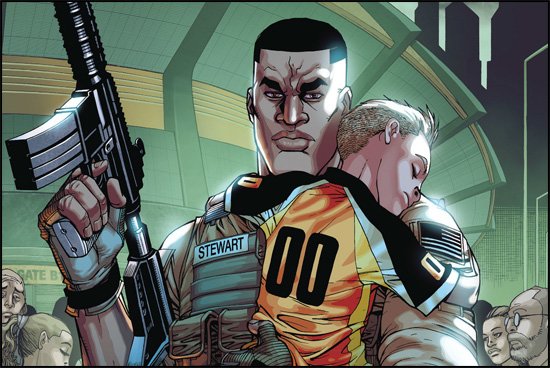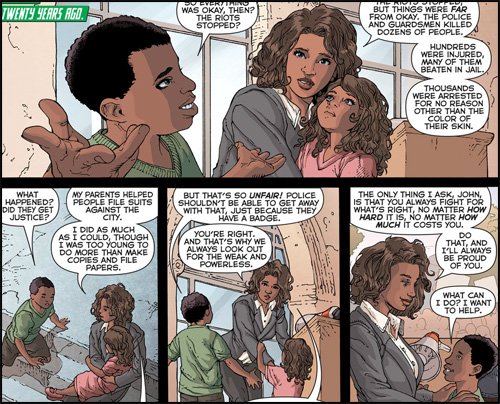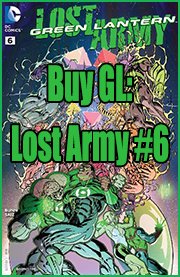Green Lantern Corps #25 Review
on November 15, 2013

This is a really beautiful, inspirational story that helps readers know John Stewart much better than than they did before. It tells us who his mother is, what led to him leaving the Marines, and how he overcomes great fear. It shows that John Stewart is a pillar of moral courage; courage to do what’s right when one doesn’t have to, even if it is unpopular or leads to adverse effects. This speaks to me personally, and connects me with the John Stewart character even more. We also see where John Stewart draws such strength from.
Overcoming great fear… A common theme in Green Lantern stories, especially since Geoff Johns started on the franchise.
Performing action movie-esque balls of steel risky feats, like leaping out of planes and charging head on into the enemy is certainly impressive, but one aspect I greatly appreciate about Van Jensen’s Green Lantern stories is how he shows us other less straight forward ways in which characters overcome great fear. They may be less glamorous, but they’re more personal, and I find them to be more stimulating.
|
This issue tells us more about John. We’re introduced to his mother and sister. |
We’ve seen Ergann’s willingness to tranquilly accept death and readiness to make the ultimate sacrifice for the sake of his friends, and Feska’s strong will to stand against the odds and do the best she can for her son. In Green Lantern Corps #25, we take a look at John Stewart, and what makes him worthy of the green ring he wears.
Though this is a great story, there are a couple things to note, which some may take issue with. First is that this story was touted as an origin story for John Stewart. I would not call it that. We are not shown John Stewart receiving a power ring or being inducted into the Green Lantern Corps. This leads us to the next issue.
In a manner of speaking, this is not really a Green Lantern story. No Corps, no aliens, no rings, no space. None of that. This is a story about a moment in John Stewart’s past, and though it is, in a sense, relevant to what’s currently going on in Green Lantern and Green Lantern Corps, that’s all it is; a moment in John’s history.
The last thing is that this is in a Batman crossover called “Zero Year.” That seems to have rubbed some the wrong way, as if Green Lantern Corps is trying to ride on the coat tails of a Batman event, but the intentions of the writers, Van Jensen and Robert Venditti, are pretty honest.
About a year ago, DC Comics ran “Zero Month,” which showed what characters were doing years ago in continuity. In natural fashion, John Stewart was entirely overlooked. This Batman event, which also delves into what certain characters were doing years ago, is an opportunity to make up for that, thus allowing for considerable character development for John Stewart. I greatly commend Jensen and Venditti for noticing discrepancies like that and seeking to rectify them. It shows how much they care about the character, which is something I’ll get into later.
While none of those points are faults, per se, people are going to approach this book with expectations. Though it didn’t pan out how I expected, I appreciate this story for what it is, as it gives us a lot of insight on John Stewart and what makes him a hero.
The issue is structured very interestingly. It’s like… a triple flashback. Using the current setting of Green Lantern Corps as default, there is one story that takes place six years ago, another that takes place twenty years ago, which is connected to a flashback to 1967. That probably sounds a bit confusing, but it makes sense in the end. It’s actually rather daring.
|
The setting of this issue is meant to greatly resemble Hurricane Katrina, as the Seaside Coliseum bears a striking resemblance to the Louisiana Superdome. |
The main story focuses on the events six years ago. At this point in time, John Stewart is a Sergeant in the U.S. Marine Corps. There is a terrible storm raging in Gotham City and the main brunt hasn’t even hit yet. The Riddler has knocked out all electricity to the city, which, of course, makes this disaster considerably worse. John’s detachment is sent in to help evacuate the people of Gotham who wanted to leave, but couldn’t. They have grouped together in Gotham’s Seaside Coliseum, and the Marines, led by Lieutenant Tasker, head in.
The squad meets with the civilians. The Marines ask who is in charge, and they’re taken to the football field to meet an individual named “Anarky.” When they reach the field, they find that there are thousands of people. The Marines’ intel said there were only a few hundred.
The masked individual named Anarky shows up and claims the Marines are invading the coliseum and that it belongs to the free people of Gotham city. The citizens attack the Marines and detain them. John Stewart is knocked out when someone hits him with a club over the head from behind.
The citizens take the Marines’ guns and lead them into a cage, where they have others trapped. It turns out the Coliseum is built upon what was once a neighborhood of Gotham populated by the lower class. The citizens are disgruntled, feeling oppressed by society, and having their homes taken from them in the name of that “temple of commercialism” throws them over the edge, with the help of Anarky’s egging on. They are striking back, empowered by Anarky’s coercing. Anarky says the establishment has always trapped the poor in a cage of poverty, drugs, and crime. Within the cage, the citizens are holding white collar individuals they’ve captured as well.
Through a megaphone, Anarky delivers a speech about seizing power, toppling the establishment, and regaining their land. It’s his hope that Gotham City will surrender the Coliseum to the people who used to live on that land.
|
Lesser known Batman villain Anarky provides much of the conflict in this story. Fans may recognize him from his recent Beware the Batman appearances on television. He has a pretty cool design here. |
Within the cage, John Stewart remembers a certain Super Bowl half time show that was held there, in which the performer seemed to appear out of thin air. He reasons that it must have been done using a trap door, and looks around for it. He finds it and leads the squad and civilians down the door while Anarky’s henchmen aren’t looking.
Still unarmed, they’re quickly pursued by the aggressive citizens, who are now equipped with their weapons. John Stewart shows more resourcefulness when he uses the pipes to blast hot steam on Anarky and his goons. It turns out the door they need to go through to escape is strongly chained up, and they’ll need their demolition kit to blast through it.
The group gathers whatever they can use as weapons from a utility closet and attacks some of the thugs who have their guns. The thugs are overcome, allowing the Marines to properly arm themselves again. Lt. Tasker (who, by the way, seems to be an analog for Hal Jordan, as he bears a resemblance to the early ’90s look of the character) gives one of the thugs a severe beating, trying to get the thug to reveal where their explosives are. Despite the Marines cheering Tasker on, John speaks out and stops Tasker from beating the person to death, even though Tasker is technically not in the wrong for doing so, as the rules of engagement authorize lethal force at the point things have gotten. John counters that by saying just because you can kill someone, doesn’t mean you should.
On the field, they’re confronted with Anarky, a group of angry civilians, and two of their own marines who Anarky captured.
Tasker wants to shoot through all of them, but John knows there has to be a better way than killing everyone. He’s aware that the poor, desperate, and angry citizens are being manipulated by Anarky, and if Anarky’s taken down, the whole rabble will fall apart. Killing the other civilians isn’t needed. Just as the squad is going to open fire, John throws down two stun grenades and rams Anarky with the butt end of his gun, defeating him.
With Anarky down, John grabs the megaphone and tells all the citizens in the stadium that a terrible storm is coming, and the stadium doesn’t have the structural support to withstand it. If they stay, they will be hurt or killed. They can leave to safety with the Marines, but no one will force them to go.
It turns out that many of the people do want to leave, and the Marines assist with the evacuation as originally planned, with John Stewart taking the lead. Anarky manages to escape.
|
Lieutenant Tasker, John’s commanding officer, parallels Hal Jordan in many ways. |
Outside in the rain, Lt. Tasker challenges John for disobeying orders and acting like he’s in charge. He threatens John Stewart with a court martial. John says he can do that if he wants, but John will tell how eager Tasker was to kill civilians. Tasker takes that personally and gets ready to punch John, but John throws him to the floor. Realizes that his actions cost him his career in the Marine Corps, John wonders if he made the right decision. He eventually reasons that he saved many lives, and even though he likely lost his military career, he did the right thing. Batman, perched above, looks down in approval of John, and swiftly moves back to the shadows.
As mentioned, there is another sequence in this issue, which begins on the first page, and is told concurrently with the main sequence, which it often parallels in ways.
This issue begins with a flashback to twenty years ago. John Stewart’s mother, Shirley Stewart is front and center at a protest supporting workers who have gone on strike due to unfair conditions. As she yells into her megaphone, conducting the audience, she gets heckled by some others with opposing views. Behind her on the stage are her two children; a very young John Stewart and his little sister. John’s mom takes time out to see them. John is glum because he’s tired of being yelled at and embarrassed by others because of what his mother is doing.
Shirley is very understanding, and says she used to be like him when she was his age. She decides to tell him a story.
This is when the book takes readers back to the Detroit Riots of 1967. The panels have a blue tint, which symbolizes the older period. There was a party going on, set up by the community league in their neighborhood. They were commemorating the return of two local soldiers who came back from the Vietnam War. The party was raided by police because the league didn’t have a liquor license. Shirley’s parents thought it was unfair, but Shirley didn’t understand why. The rules were the rules.
Word about the mass arrests had spread, and a crowd gathered in attempt to stop them. Shirley tried to calm everyone down, but no one would listen. The mob got bigger and bigger, until someone finally snapped and things got physical. Eventually, the cops were overwhelmed and they retreated. Shirley thought that was the end. She was wrong, as the next day the rioting spread, with looting, and attacks on cops. The governor called in the National Guard.
 |
|
John Stewart learns from his mother to fight for what is right, above all else, which doesn’t always put one on the side of the authorities, procedural way of doing things, or popular opinion. |
The rioters felt empowered for the first time and weren’t willing to give it up, even in the face of the military.
Shirley hoped the National Guard would stop the disastrous event, but things got worse and worse. One day, Shirley saw police stopping and arresting looters, which made her happy.
She felt they deserved to be arrested, but right in front of her, a police officer gave one of the looters a serious, completely unnecessary beating that was fueled by hatred and rage.
She was affected even more directly when a curfew was set in place to keep people off the streets, and as her family was walking home, they were stopped and held by police until the curfew started. Then the police said they could arrest them. A local soldier of the 82nd Airborne confronted the officers and told them to look for the actual criminals and not to harass families. Called on their misbehavior, the police allowed Shirley’s family to go. The soldier risked everything to help Shirley and her parents. The rioting eventually ended and the troops left, allowing the citizens to begin rebuilding.
John learns from his mother that though the rioting was over, there were devastating consequences. Dozens were killed, hundreds injured with many beaten in jail, and thousands were wrongfully arrested. Though she helped her parents file suits against the city, most police went unpunished. John is upset to hear this, but also given resolve. His mother asks him to fight for what’s right, no matter how hard, or how much it costs. John comes to respect what his mother does, and wants to join in helping her look out for the weak and powerless.
Though this issue doesn’t advance the plot, it is really good for John Stewart, as it clearly defines the contemporary version of the character, which includes elements of his different interpretations over the years. It wonderfully pays homage to John Stewart’s 1971 introductory story by Neal Adams and Denny O’Neil, in which John bravely stands up to police who are needlessly harassing citizens. It’s really nice to see the social worker aspect added back to the character. It gives John Stewart that down to earth ‘for the people’ aspect he’s been missing since Mosaic, but presents it in a more modern manner. John’s ingenuity, intelligence, and courage are proudly showcased all throughout the issue.
One of the most important things it does for John is give him a strong connection to his mother, who is his rock, his example, and source of strength. There is more of a sense of… a life to the character! Previously, during the Johns/Tomasi years, John Stewart didn’t seem to have much of a strong connection to anyone. He was kind of a weird, wondering, empty soul. On the Justice League cartoon, where considerably more effort was put into the character, John had strong connections with Hawkgirl, The Flash, Metamorpho, Batman, Vixen, Static, Katma Tui, Kilowog, and so on. There was a sense of a complete character there. One we can feel as if we know and get invested in. In comics, because the creators more or less didn’t care about him (which is stupid, since so many people in the audience and potential audience did), the character had no such substance.
Van Jensen and Robert Venditti are making John Stewart a fully realized character with his own world, cast, past, and inspirations, and they’re doing it wonderfully. This issue takes huge strides in giving the character more substance, and in five issues, Van Jensen, Robert Venditti, Bernard Chang, and Marcelo Maiolo have done more worthwhile things with John Stewart in comic continuity than anyone has for twenty years.
A very interesting aspect of this issue is that there are a lot of artists working on it. The idea is handled effectively, but I regret to say that a lot of the art is bad. Specifically, the art in what is called the main sequence, done by Vic Drujiniu on pencils and Juan Castro on inks, is not impressive at all. It’s not attractive to look at, with weird faces and poses, and an overall flat look with dim, boring coloring.
|
A big downfall of this issue is the ugly art seen throughout much of it. Here, John Stewart’s face has seen much better days. |
There are a couple things wrong with John Stewart, in particular. He doesn’t look as young as he should be, and his hair is wrong. It’s not a textbook definition of wrong, but it doesn’t make sense to me. He’s got this full head of hair instead of the crew cut fade thing we usually see him with, which is much more recalling of a military man than what we see him with in this comic. It’s just weird that he doesn’t have that hairdo while he’s in the Marines, but he does when he’s not in the Marines. It also clashes with the wonderful Bernard Chang cover. I take this to mean Drujiniu isn’t that familiar with John Stewart and doesn’t care all that much, which is a strike against him. There’s more to drawing John Stewart than just drawing a generic black guy, and thankfully, Bernard Chang understands that.
What I really like is that John Stewart’s eyes are green! I’ve been complaining about this lately, and perhaps the powers that be caught wind of it and took it into consideration. I hope so. Going further into John Stewart being more than just a generic black man, one of the main identifying traits of the modern John Stewart are his bright green eyes. It’s a little annoying when I see other characters using similar traits, like the red-eyed characters in Red Lanterns, while John Stewart, who the trait is primarily associated with, is not using it.
Marcelo Maiolo (who’s coloring I absolutely love) uses it for John Stewart, but sometimes it seems like he mutes the effect to the point where his eyes appear as a light olive-y brown, while weirdly, Fatality’s are a bright violet. Again, it slightly irks me that these other characters are using this attribute which John is the codifier of, but John is not using it. What in the world!? Over in Green Lantern, they just ink his eyes in all the way black.
I know I’m going off on a tangent about a seemingly minor thing, but if they want to make John Stewart as cool as he can be, and I honestly think they are trying to, then the eye color thing is something that needs to be gotten straight, as it is a very important visual aspect of the character that makes him unique and cool to look at. That is why Bruce Timm’s team did it! Why regress him to something duller? It should be an edict – his eyes are green!
The art in the childhood flashback sequences, done by Allen Jefferson and Rob Lean on pencils and inks respectively, is gorgeous. I greatly enjoy it. It is so full of character and nuance. I would love to see more from this art team again. There’s something gracefully mature about it, yet at the same time whimsically filled with wonder. The first and last pages of the issue are a real treat for the eyes.
After crushing it on the slamming Green Lantern Corps #24, Bernard Chang and Marcelo Maiolo deserve a breather, but this story sorely misses them, and I’m sure this issue would have been a lot better with them. Going by interviews and witnessing his work myself, Bernard Chang gives a lot of thought in telling the story, and often comes up with many clever ideas that aren’t in the script. I don’t get that feeling from Drujiniu’s work at all. He seems to do the bare minimum, and does it poorly at that.
So, anyone coming to this issue for Green Lantern action or a Batman/John Stewart team up may be disappointed. This is strictly a story to further delve into the character of John Stewart, and with how overlooked the character has been in the last decade of comics (and longer even), he sorely deserves it. Though this could have been done with little clips, blurbs, or smaller flashbacks in a story that advances the current plot, I think it’s better to firmly, clearly elucidate John Stewart, his values, and his past with this meaty, twenty-eight page story. Instead of just seeing broad strokes, more specifics are filled in about what makes him who he is, and I hope John’s mother plays a role somehow in future stories.
If DC wants John Stewart to be a bigger deal in their comic continuity -and this issue further confirms to me that they’re grooming him for such- then the character needs substance. He needs substantive filling and concreteness. All the best comic characters have that, from Peter Parker, to Clark Kent, to Bruce Wayne. We know what drives those characters, we know their values, and we know their lives. This story goes a long way in shedding light on those points for John Stewart, thus making him a more defined, and substantiated major player, and because of that, I greatly appreciate it.
John Stewart needed something like this.
4 out of 5 stars.
Read Green Lantern Corps #24 Review.
Read Green Lantern Corps #23 Review.
-
Hudson Faber
-
Hudson Faber
-
-
anonsaga
-
Desh Derringer
-



















